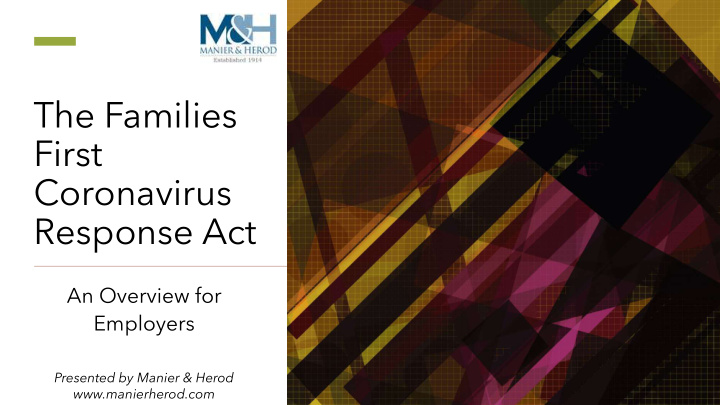



The Families First Coronavirus Response Act An Overview for Employers Presented by Manier & Herod www.manierherod.com
Disclaimer: This presentation is for educational purposes and not intended to be legal advice. In any general presentation on legal topics, the audience should seek separate legal advice on their specific cases and facts. In this unique environment dealing with the impacts of a worldwide pandemic, this advice is even more important. The legal analysis of your claim may be dependent on facts, contractual language, laws of your jurisdiction and other issues beyond the scope of this presentation. We hope you find this brief presentation beneficial. Presented by Manier & Herod www.manierherod.com
Manier & Herod Employment Law Team Fred C. Statum, III fstatum@manierherod.com Joshua D. Wilson jwilson@manierherod.com J. Lawson Hester lhester@manierherod.com Tyler Sanders tsanders@manierherod.com Jenna M. Macnair jmacnair@manierherod.com Caralisa Connell cconnell@manierherod.com Presented by Manier & Herod www.manierherod.com
The Act Applies Only To Employers With Fewer Than 500 Employees • Employers with 500 or more employees are exempt from the Act. Such Employers remain subject to existing laws and regulations. • Small businesses with fewer than 50 employees may qualify for an exemption. There are two sources of paid leave under the Act: The Emergency Paid Sick Leave Act (EPSLA); and The Emergency Family and Medical Leave Expansion Act (emergency FMLA expansion). Presented by Manier & Herod www.manierherod.com
Important Dates • By March 25, 2020, covered Employers are required to post a notice in a conspicuous location informing Employees of their rights under the Act. • The content of such notice should be published by the Secretary of Labor by March 25, 2020. • The Act itself becomes effective on April 2,2020. • The Act remain in effect through December 31, 2020. Presented by Manier & Herod www.manierherod.com
Which Employees Qualify For Expanded Family and Medical Leave? An employee qualifies if he/she is unable to work (or telework) because the employee: 1) is subject to a Federal, State, or local quarantine or isolation order 2) has been advised by a health care provider to self-quarantine 3) is experiencing COVID-19 symptoms and is seeking a medical diagnosis 4) is caring for an individual subject to a quarantine/isolation order or has been advised by medical provider to self-quarantine (see 1 and 2 above) 5) is caring for a child whose school or place of care is closed (or childcare unavailable) due to COVID-19 6) is experiencing any other substantially similar condition (as specified by the Secretary of Health and Human Services in consultation with Secretaries of Labor and Treasury) NOTE: The employee must have been employed for at least 30 days to qualify under the Emergency Family and Medical Leave Expansion Act. There is no minimum period of employment under the EPSLA. Presented by Manier & Herod www.manierherod.com
Duration of Leave is Dependent Upon the Reason for Leave • Reasons 1,2,3,4 and 6: Full-time employee eligible for up to 80 hours of leave. Part-time: number of hours that the employee works on average over a two-week period. • Reason 5: Full-time employee eligible for up to 12 weeks of leave at 40 hours per week. Part-time: number of hours that the employee is normally scheduled to work over that period. Presented by Manier & Herod www.manierherod.com
Calculation of Pay is Also Dependent Upon the Reason for Leave • Reasons 1,2 and 3: either the regular rate or the applicable minimum wage (whichever higher) up to $511 per day and $5,110 in the aggregate. • Reasons 4 and 6: 2/3 the regular rate or 2/3 applicable minimum wage, up to $200 per day and 2,000 in the aggregate. • Reason 5: 2/3 the regular rate or 2/3 the applicable minimum wage, up to $200 per day and $12,000 in the aggregate (over 12-week period). • NOTE: Under the paid FMLA section, the first 10 days may be unpaid, but the employee may use other paid leave during this time. HOWEVER, employers cannot require employees to use any other leave prior to using the EPSLA. Presented by Manier & Herod www.manierherod.com
Other Relevant Provisions • Covered employers qualify for dollar for dollar reimbursements through tax credits. • Employers are forbidden from taking adverse action against employees taking leave. • Enforcement provisions of FLSA and FMLA apply. However, there is a non-enforcement period of 30 days as long as the employer acts in good faith. Presented by Manier & Herod www.manierherod.com
Other Relevant Provisions • Reinstatement • Employers with 25 or more employees must generally reinstate employees to the same or equivalent position. • Employers with fewer than 25 employees are not so required if: The position held when leave commenced no longer exists due to economic conditions or change in • operating conditions effecting employment and caused by a public health emergency The employer makes reasonable efforts to restore the employee to a position equivalent to the • position he or she held when leave commenced. If reasonable efforts fail, employer must contact employee if equivalent position becomes available within a one-year period beginning on the earlier of the date which the qualifying need relating to the public health emergency concludes or the date that is 12 weeks after the date on which the employee’s leave commenced • The Act CANNOT diminish an employee’s preexisting rights or benefits. Presented by Manier & Herod www.manierherod.com
The Families First Coronavirus Response Act An Overview for Employers Presented by Manier & Herod www.manierherod.com
Recommend
More recommend